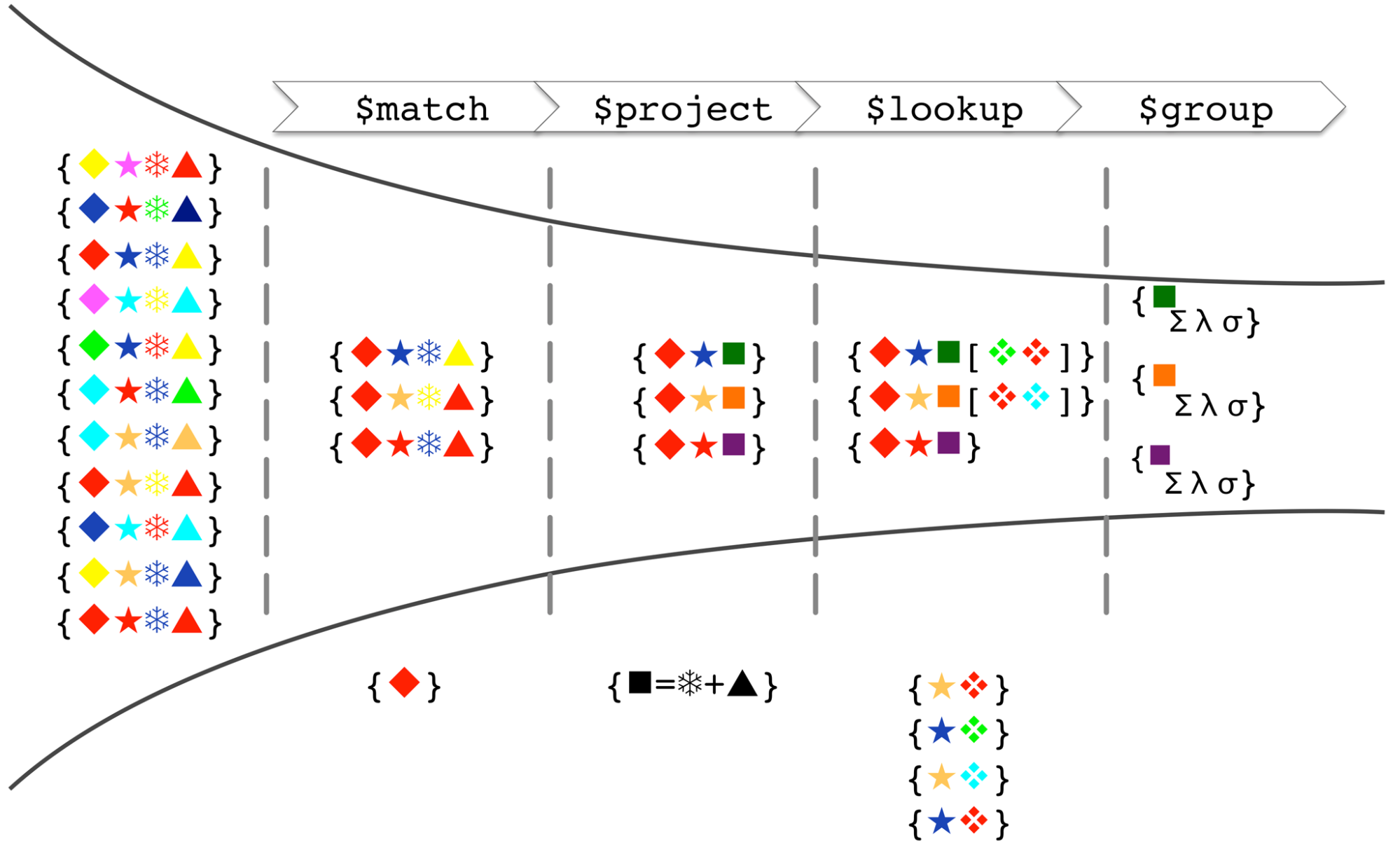(MongoDB - 5) 몽고DB의 집계 연산(Aggregation Pipeline)
몽고DB의 집계 연산에 대하여
집계 파이프라인(Aggregation Pipeline) 소개
몽고DB의 집계(aggregation) 연산에 대해서 알아보자.
몽고DB의 집계 연산은은 컬렉션(다수의 도큐먼트)에 대해서 데이터 처리 및 변환 작업을 할 수 있도록 해준다. 조금 풀어서 설명하자면, 컬렉션에 대해서 필터링, 그룹, 조인, 정렬, 분석 등의 복합적인 데이터 작업을 가능하도록 해준다. 이런 집계 연산은 aggregation pipeline을 통해서 수행할 수 있다.
공식 문서 참고 : https://www.mongodb.com/docs/manual/aggregation/#std-label-aggregation-pipeline-intro
Aggregation pipeline은 도큐먼트를 처리하기 위한 하나 이상의 스테이지로 구성되어있다.
- 각 스테이지는 인풋 도큐먼트에 대해서 연산을 수행한다
- 예) 필터링, 그룹핑, 계산, 등
- 이전 스테이지의 결과 도큐먼트들은 다음 스테이지로 넘겨진다
- 이런 스테이지들로 이루어진 집계 파이프라인의 결과로 계산된 값이 나올수도 있고, 도큐먼트가 나올수도 있다
- 뒤에서도 다루겠지만
aggregate()를 이용한 집계 파이프라인은$merge또는$out스테이지를 포함하지 않는 이상, 원본 도큐먼트를 수정하지 않는다(보통 집계 연산 과정 중에 메모리 위에 복사본을 생성해서 연산을 진행한다)
사용법에 대해서 알아보자.
syntax
<pipeline>: 파이프라인을 구성하는 스테이지의 연산들을 배열 형태로 전달한다
- 예)
[{stage1}, {stage2}, ... ]<options>: 제공하는 옵션을 설정할 수 있다
https://www.mongodb.com/blog/post/joins-and-other-aggregation-enhancements-coming-in-mongodb-3-2-part-1-of-3-introduction
사용 예시
실제 예시를 통해서 사용해보자.
예시
1
2
3
4
5
6
7
8
9
10
11
12
13
14
15
16
17
18
19
20
21
db.books.aggregate([
// Stage 1: status 'PUBLISH'인 도큐먼트를 매칭한다
{ $match: { status: 'PUBLISH' } },
// Stage 2: 필요한 필드만 프로젝션
{ $project: { title: 1, authors: 1, categories: 1 } },
// Stage 3: 'categories' 필드를 배열의 요소별로 분리한다
{ $unwind: '$categories' },
// Stage 4: 'categories' 필드로 Grouping하고 각 카테고리별로 요소를 카운트
{
$group: {
_id: '$categories', // Group by category
count: { $sum: 1 } // Count documents in each category
}
},
// Stage 5: 'count'를 기준으로 내림차순 정렬
{ $sort: { count: -1 } }
])
1
2
3
4
5
6
7
8
9
10
11
12
13
14
15
16
17
18
19
20
21
22
[
{ _id: 'Java', count: 95 },
{ _id: 'Internet', count: 41 },
{ _id: 'Microsoft .NET', count: 33 },
{ _id: 'Web Development', count: 16 },
{ _id: 'Software Engineering', count: 15 },
{ _id: 'Programming', count: 12 },
{ _id: 'Business', count: 12 },
{ _id: 'Client-Server', count: 11 },
{ _id: 'Microsoft', count: 8 },
{ _id: 'Networking', count: 7 },
{ _id: 'PowerBuilder', count: 7 },
{ _id: 'Theory', count: 7 },
{ _id: 'Perl', count: 6 },
{ _id: 'Computer Graphics', count: 6 },
{ _id: 'Python', count: 6 },
{ _id: 'Mobile Technology', count: 5 },
{ _id: 'XML', count: 4 },
{ _id: 'Object-Oriented Programming', count: 4 },
{ _id: 'Miscellaneous', count: 2 },
{ _id: 'Open Source', count: 2 }
]
집계 파이프라인에 사용할 수 있는 연산은 굉장히 많다. 공식 문서를 참고하면서 적용하자.
공식 문서 : https://www.mongodb.com/docs/manual/core/aggregation-pipeline/
Reference
이 기사는 저작권자의 CC BY 4.0 라이센스를 따릅니다.

Comments powered by Disqus.